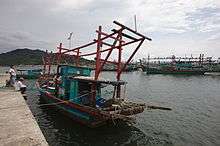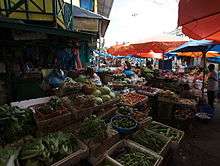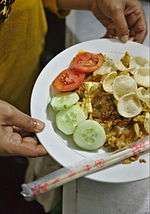Sibolga
Sibolga (formerly sometimes spelled Siboga) is a harbour town on the west coast of North Sumatra in Indonesia.
Understand

A protected natural harbour on the west coast of North Sumatra, Sibolga is close to the Nias archipelago and to thickly forested mountains. Around the turn of the 20th century it was an old trading port under English and then Dutch administration.
Its general layout is as follows:
- To the north, a road follows the bay to various villages which are less developed than the centre of town. Fisher folk seem to live here. There is also a large industrial facility if you keep going. You can hire a becak to get up here and poke around.
- To the northeast, the old road curves up over the mountains towards Lake Toba and Medan
- In the centre of town, the western waterfront has some small residential areas and a school. There's a playing field and the major bus station, which adjoins the market (pasar). West of the market are a couple of streets that have been converted to a market extension fruit vending area.
- To the southeast lies the major port which has boats to Nias and other locations.
Get in

Get around

The town is small enough to walk around but there's an oversupply of becak (motorbike sidecars) available for a small fee (think Rp 3,000).
See

If you hire a motorbike, hitch or travel a small distance by bus, there are good views of town from the main road northwards up the mountains.
Wikipedia asserts that a former English/Dutch fort used to exist on 🌍 Poncan Ketek Island ("small Poncan island') in the bay and you could hire a boat to take you there.
In town there are plenty of mosques including a large new one under construction towards the waterfront, plus at least one older church. At least three temples are also present. One of these, a Buddhist temple to Guanyin, the Mahayana Buddhist Boddhisattva of compassion, is on what seems to be the former main Chinese street (now an evening food/drink stall street). The other Chinese temple is more traditional Chinese (i.e., more Confucian/Daoist, less Buddhist) slightly to the southeast of there, featuring a large statue of a tiger and backing on to a school. A third, Buddhist temple dedicated to Maitreya (the future Buddha) is in the north just off the main road, with a prominent vihara sign visible from the street, though it may be permanently closed.
If you are careful when poking around you might notice some colonial legacy architecture.

A wander around the fishing port where the majority of fishing boats are moored may be entertaining.
Nearby 🌍 Mursala island may worth visiting. It has waterfall that directly empty to the sea and it is supposedly a location where the first King Kong movie was shot in 1933.
Do

There's really not a lot to do. Some locals swim in the water near the Hotel Wisata Indah, but it's neither particularly clean nor private.
Buy

There's a market behind the bus station which is good for provisioning. Some areas of town have interesting garments on offer, and there seems to be a fair supply of tailors.
Eat
Many local restaurants serve halal cuisine, with some of them offering a fair number of vegetarian options. Hotel restaurants are best avoided here as nobody uses them and their motivation to please customers is earth-shatteringly low. The old Chinese street, Sibolga Square, is a good venue for evening meals outdoors, featuring satay (sate), rice and noodle dishes as well as numerous fruit juice and proximity to friendly beer-vending Chinese store people.
Typical street food stalls in Sibolga Square have a blender and tropical fruits, and a wok for fried rice and noodles.
One item available in Sibolga is mi tiew (pictured below), a fried sort of wide flat rice-noodle with egg, chilli and spring onion derived from the (predominantly Cantonese/Hokkien) Chinese immigrants. This dish is flavoured with a thick soy-looking sauce (of a type typical of Indonesia), plus MSG and salt, and garnished with prawn crackers and slices of tomato and cucumber. The noodles are rice flour-based and reminiscent of 米干 (mi gan) of the Tai peoples. They could also be likened to the 粉丝 (fen si) of the modern Han Chinese, but thinner. Unlike either of those traditions, however, the integrity of the length of the noodles does not seem to be considered during preparation, leading to very short pieces after frying. The vegetarian version is identical to the meat version except that small pieces of splayed, separately cooked chicken are not dropped on top prior to serving.
Drink
Numerous fruit juice (jus) stalls are dotted around town. The going rate is Rp 7,000 per juice at day time stands. At night in Sibolga Square (the old Chinese street) the price is Rp 10,000. Beer is available in most of the hotels and some stores, though rarely refrigerated, and can be drunk in public within some social limits.
Sleep
There are quite a few hotels dotted around the north-western part of town. Prices seem to range from around Rp 160,000 through Rp 280,000 per night, some have wireless internet (generally only near the lobby), and some have hot water. There appears to be something new under construction as well.
- 🌍 Hotel Prima Indah, Jl. Brigjen Katamso No 45A-B (50m south of the northwestern end of Sibolga Square (the old Chinese street).). One of the only relatively comfortable hotels in town, featuring both hot water and Internet. Built circa 2012. Overpriced, but the location is nice for evening visits to Sibolga Sq and in its class it's essentially the only thing going. Rp 350,000.
- 🌍 Hotel Syariah CN Darussalam, Jl. Imam Bonjol No. 47, ☎ +62 631 23447. Comfortable hotel if you take superior or deluxe room. Only married couples are allowed to stay there; they may ask for marriage licenses or other proof of marriage. Two standard rooms with van in bad condition for 160'000IDR. Clean superior rooms with AC, hot water and TV for UDR 280'000 or deluxe room with bathtub for IDR 300'000..
Connect
Some hotels and a very small number of restaurants have Wi-Fi. There are some computer game/internet cafés in town as well.
Go next
Nias is the main destination, which is reachable by either of two ferries. Tickets for both can be acquired at the entrance to the port (safest), or on the boat itself (possibly not a good idea for the fast boat).
- Car ferry. Departs 20:00. c. 8-9hr. Rp 80,000pp
- Fast passenger ferry. Departs 09:00. c. 3hr. Rp 150,000pp
Buses are also available. All of these leave from the main bus station:
- Northward to Parapat (and onwards to Lake Toba) and Medan.
- Eastward to Padang Sidempuan & Padang.